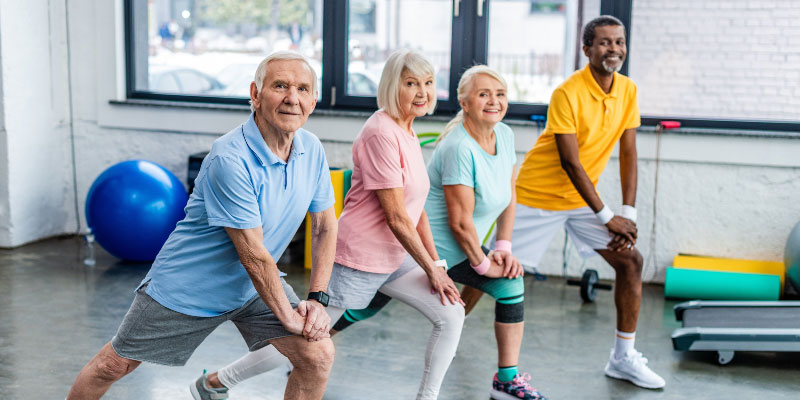The American Heart Association dedicates every February as American Heart Month, promoting heart-healthy actions we can take at all ages and raising awareness of cardiovascular disease. One important aspect of heart health is our activity level, and the U.S. Department of Health and Human Services recommends 150 minutes of moderate-intensity aerobic activity a week for good health in adults.
Seniors who struggle with their mobility might have a hard time finding heart-pumping exercises, and Midwest winter weather can make travel and exercise dangerous. But regular physical activity is important for seniors for more than heart health. Staying active helps build and maintain strength, flexibility, and endurance that help seniors maintain their independence, and regular exercise has also been linked to a reduced risk of developing dementia.
Don’t let winter weather stop you from staying active this American Heart Month! Try these tips for heart-healthy exercise this February and beyond.
1. Try Chair Exercises
For seniors with limited mobility or chronic pain, chair exercises are great to help get the body moving and build strength, flexibility, and endurance. Chair exercises also only require one piece of equipment that we already own: a good, sturdy chair.
Chair exercises come in a variety of intensities, so you can add intensity as you build your body’s strength over time. From ankle rolls and seated calf-raises to modified planks and modified burpees, there’s chair exercises fit for all abilities.
2. Find Exercise Videos Online
There’s lots of exercises out there to try, like Tai Chi, yoga, and Zumba, but committing to a class might be difficult if you’re not sure the style is right for you. Additionally, winter weather can make getting to the gym difficult.
There are plenty of exercise videos online that show you the basics and breakdown movements with helpful visuals. Search for exercise videos on free websites like YouTube to try out something new or find variations of exercises you already enjoy to mix up your routine.
3. Warm Up and Cool Down from Exercise
Exercise is important, but activity always puts us at some risk for injury. Warming up before exercise helps lower the risk of injury by gradually warming the muscles, increasing circulation, and increasing the heart rate to be ready for more intense exercise. Cooling down helps bring the heart rate back down gradually, and stretching after exercise while muscles are still warm helps improve flexibility.
Warm up activities include things like gentle arm circles and torso rotations to get the body moving and warm up the joints. Cool downs include actions like stretches, such as toe touches, shoulder stretches, or calf stretches. Cool downs help bring the body back down to a state for normal activity. If you’re a jogger, for example, you might take the last few minutes of your jog to slow to a walk.
4. Get Creative with Exercise Equipment
Investing in exercise equipment can be expensive, and bulky equipment can take up space. Get creative with equipment by using everyday objects. For example, if you want to get started with some weights, try using a couple books for a low-impact weight.
A sturdy chair or countertop are good to help you balance as well as be used for exercises like modified push ups. A folded towel is good to place under the lower back for support during floor exercises, and a paper plate can help with chair exercises like seated heel slides to help glide over carpet.
You can use a large cooking pot for toe touches: place the pot upside-down on the floor, against a wall to prevent it from sliding, then stand in front of the pot and lift your leg from the knee and tap your toe against the cooking pot. This exercise is good for balance and building strength in your hamstrings.
5. Find an Exercise Buddy
Exercising alone can be boring. Finding a buddy, like a spouse, a family member, or friend, makes exercise more fun. When you have a workout buddy, you can look forward to spending time with this person as well as getting in activity that’s beneficial for everyone. Having an accountability partner also helps keep you both on track and you’re less likely to quit.
Exercising in a group or with a buddy is also beneficial to safety. Spotting, which is supervision or assistance during a challenging exercise, from an exercise partner is also great for balance or weight exercises to help prevent falls or injury. Additionally, someone is there to help you or get help right away if an injury does occur.
Don’t forget, laughing, social activities, and spending time with our loved ones are all good for our health, too! Quality time with loved ones and social engagement can also help fight winter blues.
Exercise is good for our whole bodies: muscles, bones, brains, and hearts. Don’t let winter weather stop you from getting your heart pumping!





